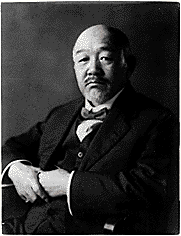Not only was Kuroda Seiki (1866-1924) a painter who left a large imprint on modern Japanese art, but he served as an educator and art administrator as well. He is credited in particular for the reform of Western-style painting in Japan during the mid Meiji period (1868-1912), and his influence reached across the entire spectrum of the arts in general. Born in Kagoshima city in Kagoshima prefecture, Kuroda moved to Kyoto at a young age as the adopted son of his uncle Kuroda Kiyotsuna. At age seventeen, he travelled to France in order to study law, but after two years switched to painting and studied under the French painter Louis-Joseph-Raphael Collin. During his nine-year stay in France, Kuroda education was based upon an academic style, and he acquired an Impressionist vision that incorporated bright outdoor light. Returning to Japan in 1893, Kuroda brought with him this representation of outdoor light which had until then not been known in Japan. Along with the liberal spirit and philosophy of which it was a part, this style proved to be highly influential. In 1896 Kuroda formed the artistic group known as the White Horse Society, and also became an instructor in the Western-style painting department of the Tokyo Art School. From then on Kuroda would go on to foster a great deal of new talent at these two institutions, eventually becoming the central pillar of the art world. In addition, as a painter Kuroda worked towards the fundamental transplantation of Western-style painting to Japan, not only with his "outdoor light" style but also with works based upon his idea of "grand composition," such as Wisdom, Impression, Sentiment, and Tale of Ancient Romance. In his late years, Kuroda was active as an art administrator, serving on the Council of Peers and as the director of the Imperial Art Academy.
